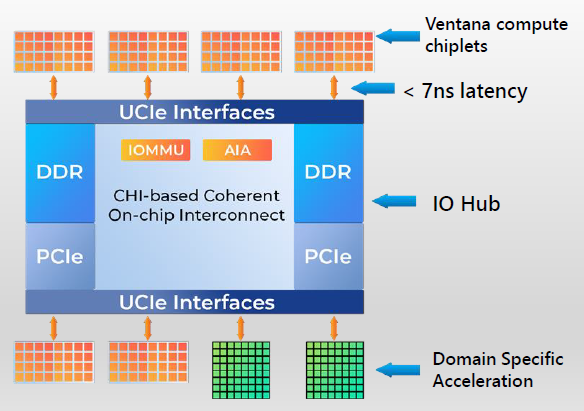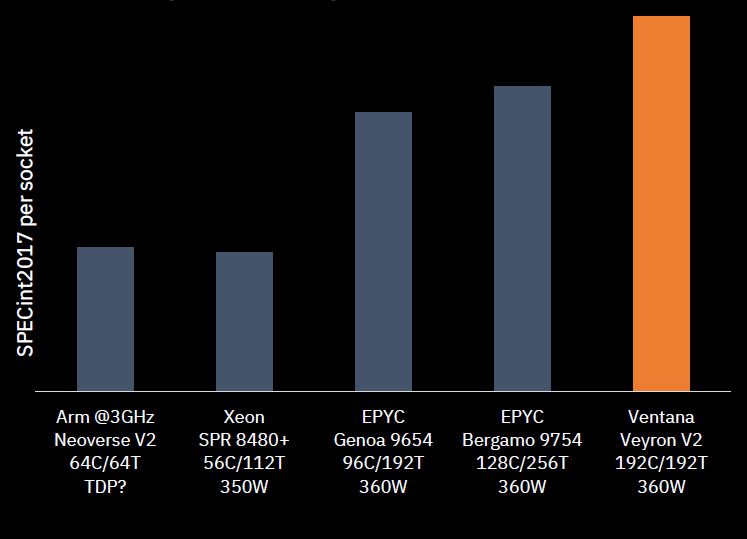 Technology peripherals
Technology peripherals
 It Industry
It Industry
 Imagination teams up with Ventana to demonstrate heterogeneous CPU-GPU SoC simulation results
Imagination teams up with Ventana to demonstrate heterogeneous CPU-GPU SoC simulation results
Imagination teams up with Ventana to demonstrate heterogeneous CPU-GPU SoC simulation results
According to news from this site on November 6, high-performance RISC-V CPU design company Ventana and Imagination jointly developed heterogeneous CPU-GPU SoC. The two companies will display their simulation models at the RISC-V Summit next week.

According to reports, both companies are major members of the RISC-V International and RISC-V Software Ecosystem (RISE) projects, and both Is a strong advocate of open architecture.
Ventana Micro Systems was founded in 2018 and its first product is the Veyron V1, launched at the RISC-V Summit in December 2022. Ventana will launch Veyron V2 next week, and this joint innovation is expected to be around this goal.

It is said that the main change in V2 compared to V1 is that RISC-V ISA will have most of the necessary features to compete with x86/Arm, such as standards Vector extensions and IOMMU specifications. It will include:
Hypervisor extension
Type 1 and Type 2 hypervisors; nested virtualization-
Advanced Interrupt Architecture (AIA)
Includes native MSI handling and interrupt virtualization
Debugging can be divided into external debugging and automatic Managed debugging, memory tracking is also a way of debugging
The content that needs to be rewritten is: rich performance events and performance counters

This site query found that the RVA23 feature set includes UCIe chip interface, 40% performance improvement, 512b vector unit AI matrix expansion, server-level IOMMU and RISE software compatibility platform , and Domain Specific Acceleration (DSA).
Related reading:
Imagination announced its upgrade to RISC-V premium membership, indicating that all its GPUs are compatible with RISC-V SoC
Advertising statement: External jumps contained in this article Redirect links (including but not limited to hyperlinks, QR codes, passwords, etc.) are used to convey more information and save selection time. The results are for reference only. All articles on this site include this statement.
The above is the detailed content of Imagination teams up with Ventana to demonstrate heterogeneous CPU-GPU SoC simulation results. For more information, please follow other related articles on the PHP Chinese website!

Hot AI Tools

Undresser.AI Undress
AI-powered app for creating realistic nude photos

AI Clothes Remover
Online AI tool for removing clothes from photos.

Undress AI Tool
Undress images for free

Clothoff.io
AI clothes remover

Video Face Swap
Swap faces in any video effortlessly with our completely free AI face swap tool!

Hot Article

Hot Tools

Notepad++7.3.1
Easy-to-use and free code editor

SublimeText3 Chinese version
Chinese version, very easy to use

Zend Studio 13.0.1
Powerful PHP integrated development environment

Dreamweaver CS6
Visual web development tools

SublimeText3 Mac version
God-level code editing software (SublimeText3)

Hot Topics
 Leak reveals key specs of Intel Arrow Lake-U, -H, -HX and -S
Jun 15, 2024 pm 09:49 PM
Leak reveals key specs of Intel Arrow Lake-U, -H, -HX and -S
Jun 15, 2024 pm 09:49 PM
IntelArrowLakeisexpectedtobebasedonthesameprocessorarchitectureasLunarLake,meaningthatIntel'sbrandnewLionCoveperformancecoreswillbecombinedwiththeeconomicalSkymontefficiencycores.WhileLunarLakeisonlyavailableasava
 The first RISC-V Android device will be commercialized on a large scale this year, and the Xuantie C930 flagship processor will be released within the year
Mar 14, 2024 pm 09:52 PM
The first RISC-V Android device will be commercialized on a large scale this year, and the Xuantie C930 flagship processor will be released within the year
Mar 14, 2024 pm 09:52 PM
According to news from this site on March 14, at the 2024 Xuantie RISC-V Ecological Conference held today, DAMO Academy announced the upgrade of a number of Xuantie processors: Xuantie C907 implemented matrix operation (Matrix) expansion for the first time. In the future, AI accelerated computing will provide more options and will be integrated into other Xuantie processors; the next generation flagship processor C930 will also be launched within the year. In addition, the first RISC-V-based Android device will also be commercialized on a large scale in 2024. At present, international and domestic mainstream operating systems have completed full adaptation to RISC-V, including Android, Linux, OpenHarmony, Debian, Fedora, Gentoo, Ubuntu, Dragon Lizard, Tongxin, op.
 Pingtouge Xuantie RISC-V processor C920, C907, R910 released, the first Android device will be launched next year
Nov 22, 2023 pm 06:38 PM
Pingtouge Xuantie RISC-V processor C920, C907, R910 released, the first Android device will be launched next year
Nov 22, 2023 pm 06:38 PM
According to news from this site on November 22, on November 21, Pingtou Ge Xuantie RISC-V launched three new processors: C907 that realizes AI matrix expansion for the first time, C920 that meets the Vector1.0 standard, and real-time processor R910. It claims to accelerate the large-scale commercial implementation of RISC-V in scenarios and fields such as autonomous driving, artificial intelligence, enterprise-level SSD, and network communications. According to reports, based on software and hardware collaborative optimization, the C920 has been upgraded to support the latest Vector1.0 standard, which can achieve more accurate and stable task allocation, allowing each thread to maximize performance, thereby improving overall performance. C920 has improved AI performance by up to 3.8 times compared to the previous generation, and can run Transformer models, making it suitable for machine learning.
 Snapdragon X Elite CPU performance nearly identical on battery and plugged-in in Vivobook S15 benchmarks
Jun 20, 2024 pm 03:59 PM
Snapdragon X Elite CPU performance nearly identical on battery and plugged-in in Vivobook S15 benchmarks
Jun 20, 2024 pm 03:59 PM
Despite the hype surrounding the Qualcomm Snapdragon X Elite, it has been a rather mediocre launch. In our review, we found that the most impressive part of the new Qualcomm Snapdragon X Elite X1E-78-100-powered Asus Vivobook S 15 was the seamlessnes
 The world's first RISC-V laptop upgrades to the second generation, DC-ROMA RISC-V Laptop II will be pre-installed with Ubuntu system
Jun 14, 2024 am 09:39 AM
The world's first RISC-V laptop upgrades to the second generation, DC-ROMA RISC-V Laptop II will be pre-installed with Ubuntu system
Jun 14, 2024 am 09:39 AM
This site reported on June 13 that DC-ROMA is the world's first native RISC-V development laptop led by the RISC-V Foundation, developed by Deep Digital Intelligence and debugged by Jianshi Technology. It was released in March last year. ▲DC-ROMARISC-VLaptopII After more than a year, Deepin Digital announced the launch of DC-ROMARISC-VLaptopII notebook, which is the second generation of the product. This machine is also the world’s first RISC-V laptop with Ubuntu pre-installed. The new DC-ROMARISC-VLaptopII is equipped with the "SpacemiTKeyStoneK1" 8-core RISC-VCPU for the first time, running at a maximum speed of 2.0GHz
 Snapdragon X Elite CPU performance nearly identical on battery vs AC power in Vivobook S15 benchmarks
Jun 21, 2024 am 06:50 AM
Snapdragon X Elite CPU performance nearly identical on battery vs AC power in Vivobook S15 benchmarks
Jun 21, 2024 am 06:50 AM
Despite the hype surrounding the Qualcomm Snapdragon X Elite, it has been a rather mediocre launch. In our review, we found that the most impressive part of the new Qualcomm Snapdragon X Elite X1E-78-100-powered Asus Vivobook S 15 was the seamlessnes
 Qualcomm releases Snapdragon 6 Gen3 processor: Samsung's 4nm process greatly improves performance
Sep 02, 2024 pm 12:44 PM
Qualcomm releases Snapdragon 6 Gen3 processor: Samsung's 4nm process greatly improves performance
Sep 02, 2024 pm 12:44 PM
According to news on September 2, Qualcomm recently released the Snapdragon 6Gen3 entry-level processor, which has significantly improved performance compared to the previous generation. Snapdragon 6Gen3 is codenamed M6475-AB and is built using a 4nm process. The CPU is 4×2.40GHz CortexA78+4×1.80GHz CortexA55, and the GPU is Adreno710. 1. Significantly improved performance: CPU performance is improved by 10%, GPU performance is improved by over 30%, and AI performance is improved Improve the smooth and efficient experience by over 20%: multitasking is smoother, applications load faster, and gaming effects are better. Advanced AI functions: supports AI functions such as picture removal, which are in line with mainstream models. Snapdragon 6Gen3 also supports LPDDR4x and LPDD.
 What is the difference between riscv architecture and arm
Aug 22, 2023 pm 01:47 PM
What is the difference between riscv architecture and arm
Aug 22, 2023 pm 01:47 PM
The difference between riscv architecture and arm: 1. Design philosophy. The riscv design philosophy is to simplify the instruction set and improve instruction execution efficiency. The arm design philosophy is to add some special instructions and registers while maintaining the simplicity of the instruction set to improve specific application scenarios. Performance; 2. Openness, riscv instruction set architecture specifications are publicly available and free to use, arm has some restrictions on the definition and use of its instruction set architecture; 3. Application fields, riscv is used in embedded systems, mobile devices, high-performance computing, etc. , arm is used in mobile devices and embedded systems.





